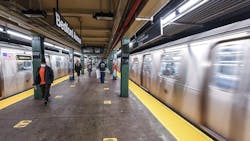NYU researchers confirm ‘river-tunnel effect’ where air quality degrades in subway stations near river crossings
New research from New York University (NYU) Grossman School of Medicine found subway stations near river tunnels can have significantly higher concentrations of potentially dangerous particles in what they call a “river-tunnel effect.”
Concentrations of potentially dangerous particles can be between 80 percent and 130 percent higher subway stations neighboring river tunnels versus those stations that were two or three stop further from the rivers. Researchers hope their study will help prioritize mitigation and cleaning efforts.
The study, “Investigation of a river-tunnel effect on PM2.5 concentrations in New York City subway stations,” was published Dec. 30 in the journal Transportation Research Part D: Transport and Environment.
Researchers collected more than 100 air samples at 54 Metropolitan Transportation Authority subway stations during morning rush periods between February and March 2022. The study’s authors found the “river-tunnel effect” occurs because tunnels beneath water have limited ventilation, which allows debris to build up over time.
The research team found pollutant levels in all measured stations exceeded the exposure limit advised by the Environmental Protection Agency. Particle buildup on the B Line, which traverses over the East River by a bridge rather than under by a tunnel, was measured for comparison purposes. The two stations closest to the river crossing were lower than at stations farther away.
"Our findings help explain why some underground subway stations are more polluted than others," said study lead author David Luglio, MS; a doctoral student at NYU Grossman School of Medicine. "Those subway stations closest to rivers clearly must be prioritized during cleaning efforts."
The study team examined other potential contributors such as station size, depth and age in addition to the proximity to a river tunnel. Luglio says a subway station’s proximity to a river tunnel followed by its age were indicators of high pollutant levels while size and depth did not appear to play a major role.
"Now that our results have identified key contributors to poor air quality in New York City's underground subway stations, we have a better idea of where to improve conditions in the most contaminated areas of the transit system," said Terry Gordon, Ph.D., the study’s senior author and professor in the Department of Medicine at NYU Langone Health. "Increasing ventilation and scrubbing the tunnel walls and floors to remove continually recycling debris may make stations safer for riders and transit workers.”
Gordon explains the study team will next examine the effects of subway contaminates on human cells to better assess what level of exposure could pose a risk to human health.
-----------------
The study, "Investigation of a river-tunnel effect on PM2.5 concentrations in New York City subway stations," is available for reading here.

Mischa Wanek-Libman | Group Editorial Director
Mischa Wanek-Libman is director of communications with Transdev North America. She has more than 20 years of experience working in the transportation industry covering construction projects, engineering challenges, transit and rail operations and best practices.
Wanek-Libman has held top editorial positions at freight rail and public transportation business-to-business publications including as editor-in-chief and editorial director of Mass Transit from 2018-2024. She has been recognized for editorial excellence through her individual work, as well as for collaborative content.
She is an active member of the American Public Transportation Association's Marketing and Communications Committee and served 14 years as a Board Observer on the National Railroad Construction and Maintenance Association (NRC) Board of Directors.
She is a graduate of Drake University in Des Moines, Iowa, where she earned a Bachelor of Arts degree in Journalism and Mass Communication.


